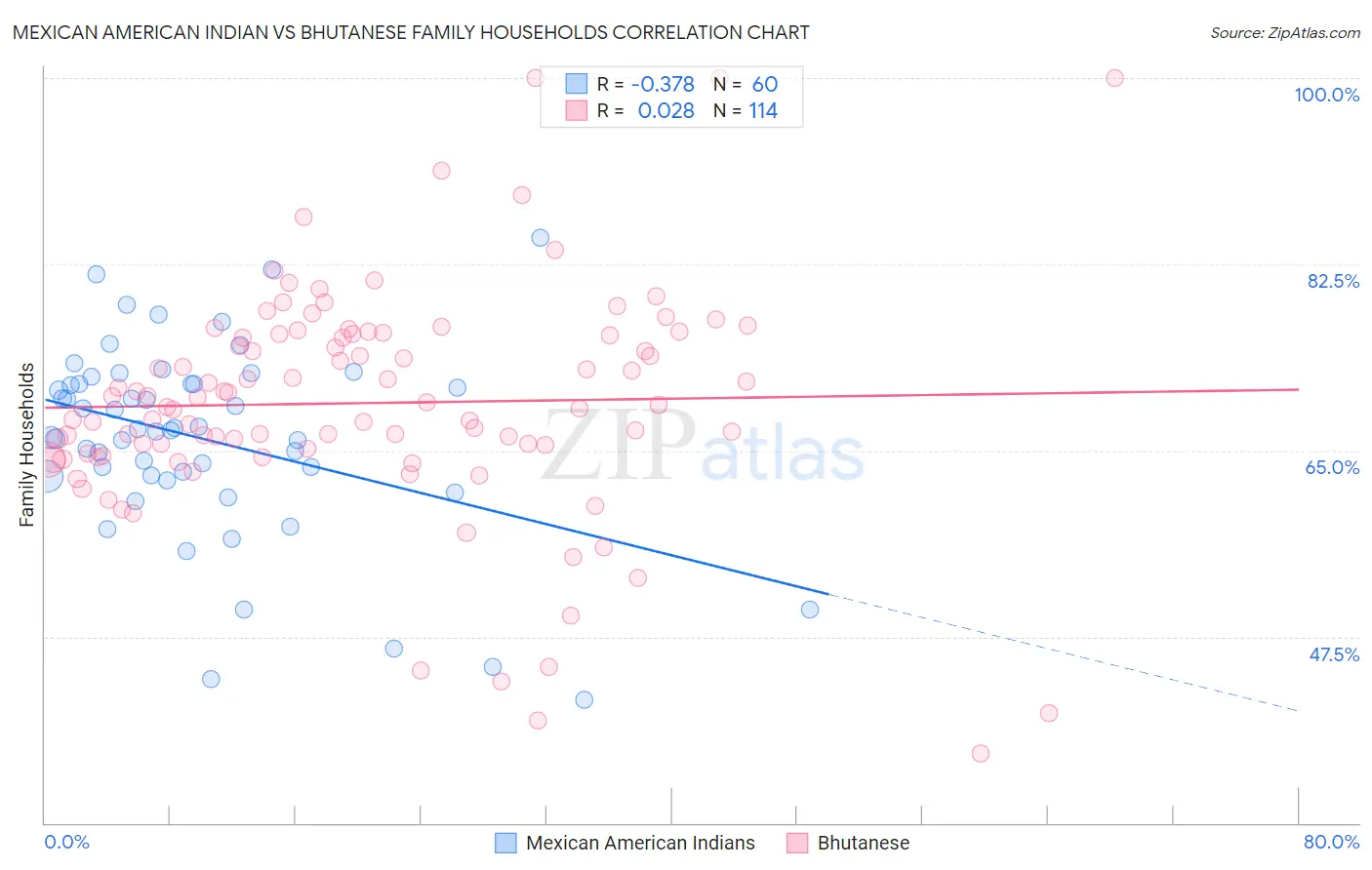Mexican American Indian vs Bhutanese Family Households
COMPARE
Mexican American Indian
Bhutanese
Family Households
Family Households Comparison
Mexican American Indians
Bhutanese
67.0%
FAMILY HOUSEHOLDS
100.0/ 100
METRIC RATING
38th/ 347
METRIC RANK
65.9%
FAMILY HOUSEHOLDS
99.9/ 100
METRIC RATING
71st/ 347
METRIC RANK
Mexican American Indian vs Bhutanese Family Households Correlation Chart
The statistical analysis conducted on geographies consisting of 317,495,580 people shows a mild negative correlation between the proportion of Mexican American Indians and percentage of family households in the United States with a correlation coefficient (R) of -0.378 and weighted average of 67.0%. Similarly, the statistical analysis conducted on geographies consisting of 455,147,880 people shows no correlation between the proportion of Bhutanese and percentage of family households in the United States with a correlation coefficient (R) of 0.028 and weighted average of 65.9%, a difference of 1.8%.

Family Households Correlation Summary
| Measurement | Mexican American Indian | Bhutanese |
| Minimum | 41.6% | 36.6% |
| Maximum | 85.0% | 100.0% |
| Range | 43.4% | 63.4% |
| Mean | 66.1% | 69.5% |
| Median | 67.0% | 69.4% |
| Interquartile 25% (IQ1) | 62.6% | 64.7% |
| Interquartile 75% (IQ3) | 71.3% | 75.9% |
| Interquartile Range (IQR) | 8.6% | 11.2% |
| Standard Deviation (Sample) | 9.1% | 10.8% |
| Standard Deviation (Population) | 9.0% | 10.8% |
Similar Demographics by Family Households
Demographics Similar to Mexican American Indians by Family Households
In terms of family households, the demographic groups most similar to Mexican American Indians are Immigrants from El Salvador (67.0%, a difference of 0.020%), Tsimshian (67.1%, a difference of 0.10%), Peruvian (67.1%, a difference of 0.17%), Tohono O'odham (67.1%, a difference of 0.18%), and Salvadoran (67.2%, a difference of 0.23%).
| Demographics | Rating | Rank | Family Households |
| Immigrants | Latin America | 100.0 /100 | #31 | Exceptional 67.2% |
| Nepalese | 100.0 /100 | #32 | Exceptional 67.2% |
| Salvadorans | 100.0 /100 | #33 | Exceptional 67.2% |
| Thais | 100.0 /100 | #34 | Exceptional 67.2% |
| Tohono O'odham | 100.0 /100 | #35 | Exceptional 67.1% |
| Peruvians | 100.0 /100 | #36 | Exceptional 67.1% |
| Tsimshian | 100.0 /100 | #37 | Exceptional 67.1% |
| Mexican American Indians | 100.0 /100 | #38 | Exceptional 67.0% |
| Immigrants | El Salvador | 100.0 /100 | #39 | Exceptional 67.0% |
| Guamanians/Chamorros | 100.0 /100 | #40 | Exceptional 66.6% |
| Immigrants | Bolivia | 100.0 /100 | #41 | Exceptional 66.6% |
| Menominee | 100.0 /100 | #42 | Exceptional 66.5% |
| Apache | 100.0 /100 | #43 | Exceptional 66.5% |
| Asians | 100.0 /100 | #44 | Exceptional 66.5% |
| Venezuelans | 100.0 /100 | #45 | Exceptional 66.5% |
Demographics Similar to Bhutanese by Family Households
In terms of family households, the demographic groups most similar to Bhutanese are Malaysian (65.9%, a difference of 0.020%), Immigrants from Afghanistan (65.9%, a difference of 0.020%), Portuguese (65.8%, a difference of 0.050%), Japanese (65.9%, a difference of 0.060%), and Fijian (65.9%, a difference of 0.080%).
| Demographics | Rating | Rank | Family Households |
| Pima | 99.9 /100 | #64 | Exceptional 65.9% |
| Costa Ricans | 99.9 /100 | #65 | Exceptional 65.9% |
| Fijians | 99.9 /100 | #66 | Exceptional 65.9% |
| Filipinos | 99.9 /100 | #67 | Exceptional 65.9% |
| Japanese | 99.9 /100 | #68 | Exceptional 65.9% |
| Malaysians | 99.9 /100 | #69 | Exceptional 65.9% |
| Immigrants | Afghanistan | 99.9 /100 | #70 | Exceptional 65.9% |
| Bhutanese | 99.9 /100 | #71 | Exceptional 65.9% |
| Portuguese | 99.9 /100 | #72 | Exceptional 65.8% |
| Laotians | 99.9 /100 | #73 | Exceptional 65.8% |
| Burmese | 99.9 /100 | #74 | Exceptional 65.7% |
| Houma | 99.9 /100 | #75 | Exceptional 65.7% |
| Immigrants | Azores | 99.8 /100 | #76 | Exceptional 65.6% |
| Immigrants | South America | 99.8 /100 | #77 | Exceptional 65.6% |
| Yaqui | 99.8 /100 | #78 | Exceptional 65.6% |